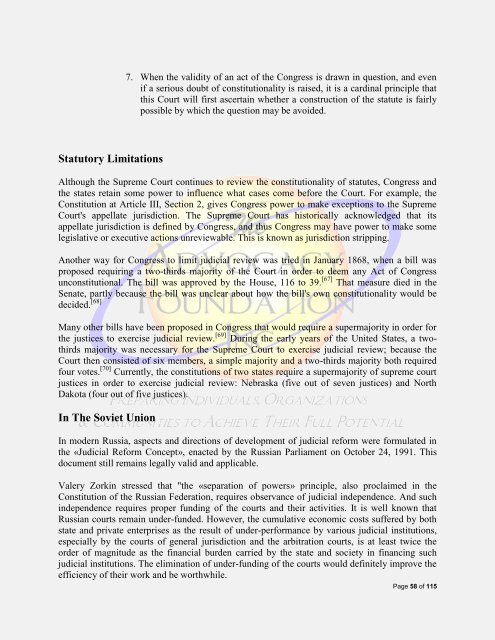Judicial ReEngineering
Judicial ReEngineering
Judicial ReEngineering
Create successful ePaper yourself
Turn your PDF publications into a flip-book with our unique Google optimized e-Paper software.
7. When the validity of an act of the Congress is drawn in question, and even<br />
if a serious doubt of constitutionality is raised, it is a cardinal principle that<br />
this Court will first ascertain whether a construction of the statute is fairly<br />
possible by which the question may be avoided.<br />
Statutory Limitations<br />
Although the Supreme Court continues to review the constitutionality of statutes, Congress and<br />
the states retain some power to influence what cases come before the Court. For example, the<br />
Constitution at Article III, Section 2, gives Congress power to make exceptions to the Supreme<br />
Court's appellate jurisdiction. The Supreme Court has historically acknowledged that its<br />
appellate jurisdiction is defined by Congress, and thus Congress may have power to make some<br />
legislative or executive actions unreviewable. This is known as jurisdiction stripping.<br />
Another way for Congress to limit judicial review was tried in January 1868, when a bill was<br />
proposed requiring a two-thirds majority of the Court in order to deem any Act of Congress<br />
unconstitutional. The bill was approved by the House, 116 to 39. [67] That measure died in the<br />
Senate, partly because the bill was unclear about how the bill's own constitutionality would be<br />
decided. [68]<br />
Many other bills have been proposed in Congress that would require a supermajority in order for<br />
the justices to exercise judicial review. [69] During the early years of the United States, a twothirds<br />
majority was necessary for the Supreme Court to exercise judicial review; because the<br />
Court then consisted of six members, a simple majority and a two-thirds majority both required<br />
four votes. [70] Currently, the constitutions of two states require a supermajority of supreme court<br />
justices in order to exercise judicial review: Nebraska (five out of seven justices) and North<br />
Dakota (four out of five justices).<br />
In The Soviet Union<br />
In modern Russia, aspects and directions of development of judicial reform were formulated in<br />
the «<strong>Judicial</strong> Reform Concept», enacted by the Russian Parliament on October 24, 1991. This<br />
document still remains legally valid and applicable.<br />
Valery Zorkin stressed that "the «separation of powers» principle, also proclaimed in the<br />
Constitution of the Russian Federation, requires observance of judicial independence. And such<br />
independence requires proper funding of the courts and their activities. It is well known that<br />
Russian courts remain under-funded. However, the cumulative economic costs suffered by both<br />
state and private enterprises as the result of under-performance by various judicial institutions,<br />
especially by the courts of general jurisdiction and the arbitration courts, is at least twice the<br />
order of magnitude as the financial burden carried by the state and society in financing such<br />
judicial institutions. The elimination of under-funding of the courts would definitely improve the<br />
efficiency of their work and be worthwhile.<br />
Page 58 of 115

















